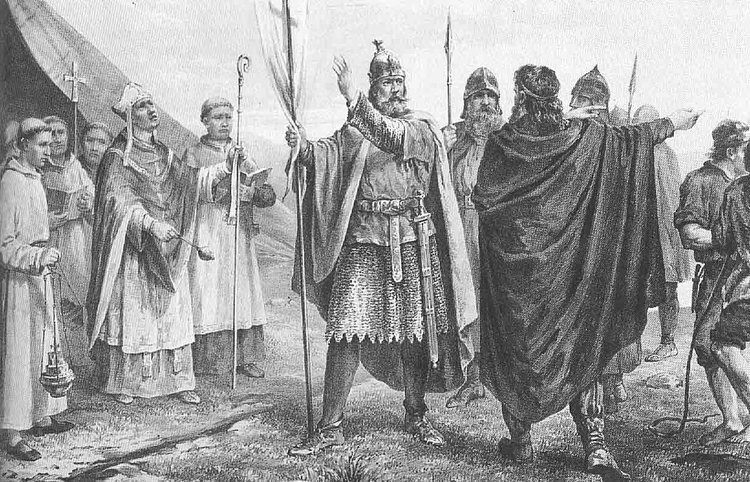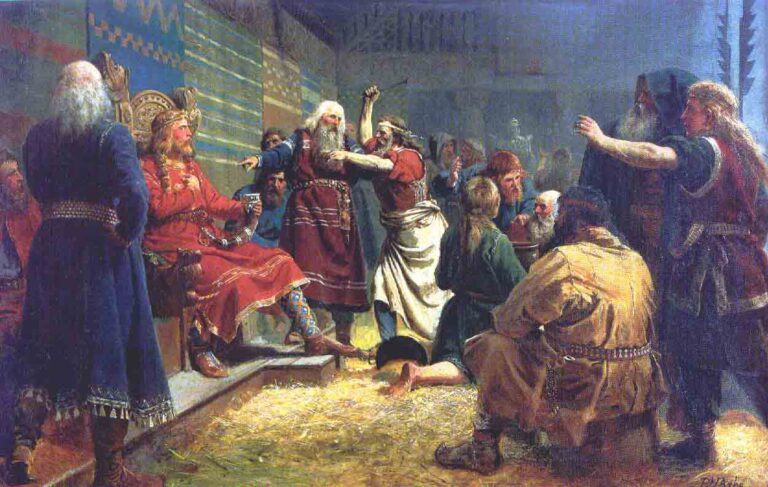In my latest novel, I have the pleasure of bringing my readers into the world and life of Olaf Tryggvason, of the most legendary and enigmatic kings of the Viking Age. He is described as a leader of men, “exceeding fair and tall to look upon and of mighty stature and of great strength. And in prowess in sports, so it is told, was he the best of all the Norsemen.” But he is also seen as vicious and cruel to those who oppose his will. His life covers a lot of ground (literally) and is filled with adventure, which is why I decided to make his story a series and not a single book.

My first novel in the series, Forged by Iron, focuses specifically on the exploits and adventures of Olaf Tryggvason’s youth. And so I have dedicated this post to describing the background story of Olaf’s lineage, his birthplace, his early life, and the circumstances that defined his upbringing. Hopefully, this will act as a bit more background for the book should you decide to read it.
The Lineage of Olaf Tryggvason
If you take Snorre Sturlasson’s Heimskinrgla at face value, then Olaf Tryggvason is the son of Trygvi Olafsson, who is the ruler of a district in Viking Age Norway called Vingulmark. It is an area he had been granted to rule by his uncle, Hakon Haraldsson (or Hakon the Good), the youngest son of Harald Fairhair. Trygvi Olafsson is in turn the son of Olaf Haraldsson, the older half-brother of Hakon who was killed by another half-brother, Erik Bloodaxe, the favorite of their mutual father Harald. Snorre makes this family tree clear in Heimskringla in an effort to legitimize Olaf Tryggvason’s claim to the High Seat of Norway, though we do not yet know if it is actually true, in part because Heimskringla was written ~250 years after Olaf Tryggvason lived.
There are other, earlier, mentions of Olaf, such as the poems of Hallfreðr Óttarsson the Troublesome, a contemporary skald who served in Olaf’s court, and Adam of Bremen’s Gesta Hammaburgensis Ecclesiae Pontificum (“Deeds of the Bishops of Hamburg”), written ca. 70 years after Olaf’s death, neither of which mention Olaf’s lineage.
Still, even if you take Heimskringla to be moderately true, that is, to think of Olaf maybe not as a direct descendent of Harald Fairhair, but more as the son of a nobleman in Vingulmark, then you have to think of Olaf as at least noble, and maybe someone with designs for something greater.

The World of Olaf Tryggvason’s Youth
Olaf Tryggvason was born at a tumultuous time in the history of Norway. Years before, Hakon Haraldsson (Hakon the Good) had wrested the Northern kingdom from his half-brother, Erik Bloodaxe. Erik fled with his family to the Orkneys, never to return. Upon his death, the sons of Erik came back to reclaim what was taken from their father. Backed by the Danes, those sons fought a series of battles against Hakon the Good until they finally defeated him. The senior surviving sons of Erik settled in the west of the land along with their mother, Gunnhild.
However, those sons had failed to exterminate the nobility who supported Hakon, namely, Sigurd Ladejarl in Trondheim, Gudrod Bjornson in the Vestfold, and Trygvi Olafsson in the Ostfold. All of them either kin or friends to Hakon Haraldsson. When Erik’s sons defeated Hakon, their next step was to rid the land of those men. This they did, using ruses and covert methods to kill them, one by one.
The last of Hakon’s supporters to die is Trygvi, Olaf’s father.
The Birth of Olaf Tryggvason
There is much debate about how, when and where Olaf’s birth actually happened. If you believe Heimkringla, then Olaf was born on an island in the middle of a lake in Vingulmark as his mother hid from the agents of Erik’s sons. It is a story that reminds us of another birth, this one in the Gospel of Luke in a manger. Since the church approved of Olaf’s later conversion of Norway, it is quite possible it wanted to build up Olaf’s reputation as some sort of savior, hence they drew the parallel.
It is just as likely that Olaf was born at home and probably some years before his father was killed. I say this primarily because of the timeline of events. Olaf’s grandfather was killed by Erik Bloodaxe in ca. AD 934 at the battle of Mollebakken. Olaf’s father, Trygvi, is a boy at the time and flees to the Uplands. Trygvi, in turn, is killed by Erik’s sons in ca. AD 963. We do not know exactly when Trygvi was born, but it is believed he is older than his uncle, Hakon. Even if he is one year older, i.e. born in AD 917, he would be 46 at the time of his death and his son’s birth. That, of course, is not inconceivable (after all, Harald Fairfair purportedly had Hakon when he was 70), but it is unlikely. It is more likely that Olaf is a boy or at least a child at the time of this father’s death at the hands of Erik’s sons, and flees as a youth with his mother to Sweden.
The Aftermath
Olaf escapes to Sweden with revenge on his mind, leaving behind a realm ruled by a vassal to Denmark and ripe to reclaim. Yet to get that chance, Olaf must first survive his flight to the land of the Rus, where his maternal uncle lives, then build his reputation, his wealth and his following. It is a journey that takes years and sees Olaf through innumerable adventures as he traverses much of the Viking world. The first step of that journey is what I tell in Forged by Iron.
Sign Up
Sign up to have new blog posts and other free content delivered to you monthly!



